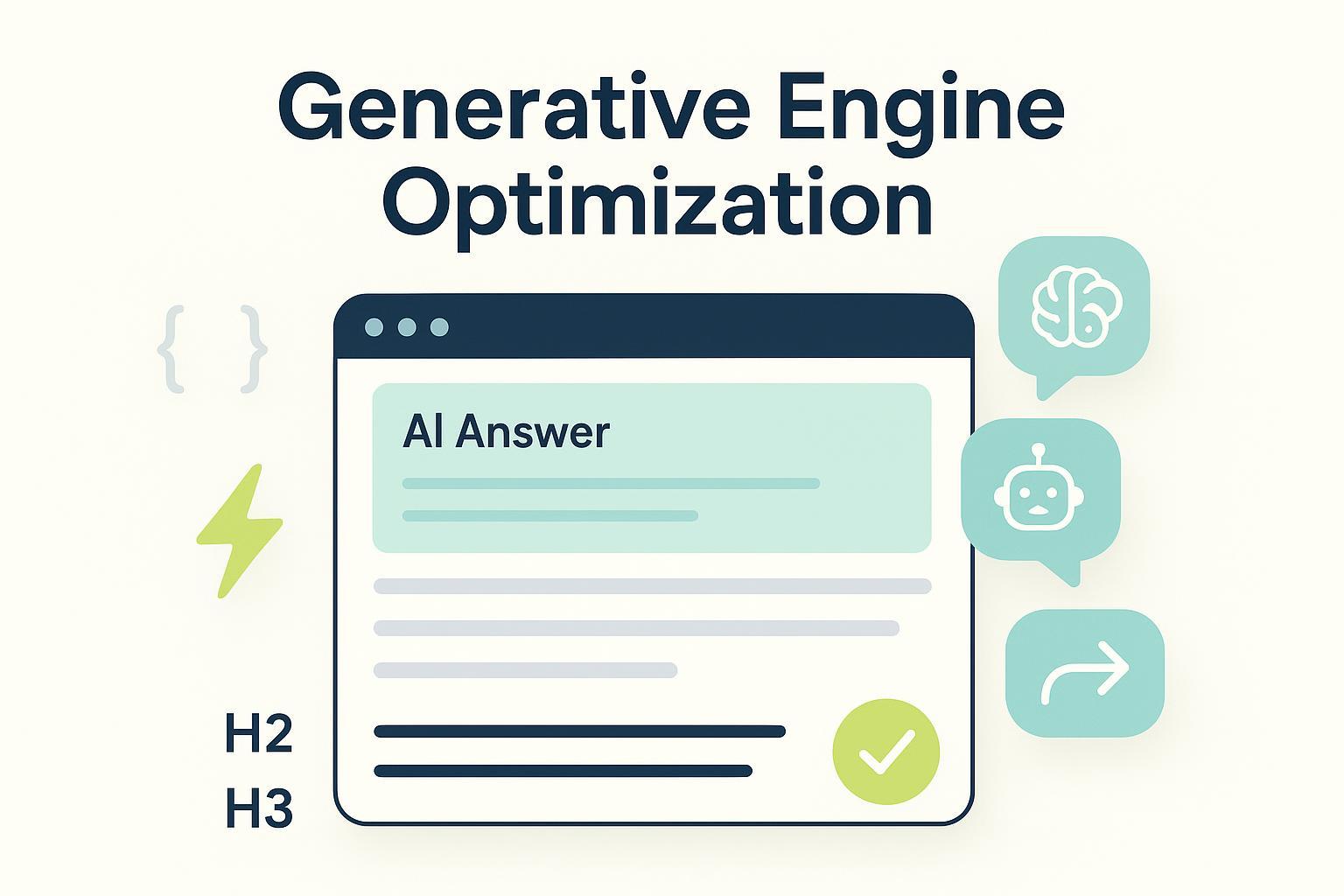Content Clustering for GEO: A Practical Framework
Boost AI visibility and user engagement with content clustering. Learn how structured topic clusters enhance GEO and create a seamless user experience.


Content clustering groups similar topics into connected pieces of content. This method helps you build a clear structure where each part supports the others. It also boosts your visibility as search engines see you as an expert on certain topics.
AI-powered search engines prefer well-organized content. For instance, Workfellow grew its organic traffic 22 times in one year by using Generative Engine Optimization. Visitors from AI searches had a top conversion rate of 2.3%, compared to the usual 0.7%. By using content clustering, you can achieve similar results and make your site more useful and user-friendly.
Key Takeaways
Content clustering groups similar topics together to make your site easier to navigate and find.
GEO, or Generative Engine Optimization, improves content for AI searches by keeping it clear and well-organized, helping it show up in search results.
Creating clusters around main ideas helps search engines understand your site, making it more likely to be shared and improving how users interact with it.
Update your content often to keep it new and useful, since AI likes fresh information and rewards updated sites with better visibility.
Track how your content is doing using important measurements to find ways to improve and keep your plan working well over time.
Understanding GEO and Content Clustering

What is Generative Engine Optimization (GEO)?
Generative Engine Optimization (GEO) helps content work better with AI searches. Unlike regular SEO, GEO focuses on clear and organized information. Using headings, bullet points, and related topics makes content easier for AI to use. This type of content is more likely to appear in summaries or answer boxes. GEO also values detailed content that shows expertise, making it more useful for AI systems.
Certain metrics show how well GEO works with search engines. One is citation tracking, which counts how often AI mentions your content. Another is visibility, which checks where your content shows up in AI results. Engagement metrics, like how users interact with AI answers, are also important.
Metric Type | Description |
|---|---|
Citation Tracking | Counts how often AI mentions your content and in what context. |
Visibility Metrics | Tracks where your content appears in AI summaries or answers. |
Engagement Indicators | Measures user actions, like clicks or traffic after AI responses. |
How Content Clustering Enhances GEO
Content clusters are key to making GEO work well. They group similar topics together, creating a web of connected information. This setup helps AI understand your content better. Clusters also make your content more complete and relevant, increasing its chances of being used by AI. Research shows clustering improves validation metrics by 22.26% and reduces disorganization by 70.04%, proving its effectiveness.
Why AI-Driven Search Engines Value Content Clusters
AI search engines like content clusters because they make finding information easier. Clusters show how topics connect, helping AI give better answers. For example, one SaaS company improved its AI visibility by 50% in just two months. They did this by linking related pages and updating old content. This shows how clusters boost both visibility and user satisfaction.
A Practical Framework for Content Clustering
Finding Topics and Choosing Main Content
Start by picking the right topics and main content. Main content acts as the center of your cluster. It connects to smaller, related topics. First, learn what your audience wants and searches for. This makes sure your content matches their needs.
Key Points | Explanation |
|---|---|
Main Pages | Detailed articles that are the main hub for a topic. |
Types of Main Content | Includes guides, tutorials, and "what is" articles for different needs. |
User Intent Matters | Knowing user intent helps you focus on popular search topics. |
For example, if your site is about digital marketing, your main page could be "The Ultimate Guide to Social Media Marketing." This page would cover the topic broadly. It could link to smaller pages like "How to Make a Social Media Calendar" or "Best Social Media Tools for 2023." Studies show clustering improves learning models by organizing data better. Even small accuracy gains can make a big difference for organic data.
Building Clusters Around Main Topics
After choosing your main content, create clusters around it. Each cluster page should focus on one subtopic. Link these pages back to the main page. This method organizes your content and helps search engines see topic connections.
For example, a main page called "Beer 101: The Guide to Drinking & Enjoying Beer" could link to:
"What is Beer?"
"A Short History of Beer"
"How Yeast Works in Beer"
"Beer and Food Pairing Tips"
This idea, made popular by HubSpot, works well for SEO and user interest. Salesforce uses this for their CRM content. Their CRM main page links to related articles, helping them rank high for tough keywords. Using this strategy builds a strong web of information for users and search engines.
Using Links for Easy Navigation
Links connect your cluster pages and main page. They help users move through your site easily. Links also show search engines which pages matter most, boosting your site’s rank.
Linking pages with smart strategies improves navigation. Users find related content faster, stay longer, and leave less often. Links also boost site authority by showing search engines important pages. This spreads link power and helps rankings.
To do this well:
Link each cluster page to the main page to show importance.
Connect cluster pages to each other to show relationships.
Use clear link text to explain the link’s purpose.
For example, if your main page is "Social Media Marketing," a cluster page on "Making a Social Media Calendar" could link to another cluster page on "Best Social Media Tools for 2023." This keeps visitors interested and helps search engines find more pages, improving your site’s performance.
Optimizing Content for AI Search Engines
AI search engines like content that fits their needs. To make your content better for AI, keep it simple and well-organized. This helps AI easily find and show your information.
Use formats that AI prefers. Add headings, bullet points, and short paragraphs to make reading easier. Clear URLs, meta descriptions, and headings help AI understand your content. For example, a URL like www.example.com/social-media-tips works better than www.example.com/page123.
Update your content often. AI likes fresh information, so add new facts to old articles. Present your content in a clear way. Use tables, lists, or infographics to make it easy for AI to share with users.
Make sure your website is easy for AI to explore. Use clean code and avoid extra scripts that slow it down. Faster websites make users happy and improve your rank in AI search results.
Check how well your content is doing. See how often AI uses your content in answers. Track branded searches to measure how people recognize your brand. Look at user actions like scrolling, time spent, and clicks to learn what works.
Tip: Tools like Google Search Console can help you track these numbers. They show how well your content changes are working.
Monitoring and Iterating for Continuous Improvement
To keep your content strong, check its performance often. Look at key metrics to see what works best. Pick metrics that match your goals, like more traffic or better AI mentions.
Review reports to find weak spots. If users don’t interact much with a page, update it or make it clearer. Changing your plan based on these insights keeps your content useful and competitive.
Evidence Type | Description |
|---|---|
Shows which strategies bring the best results. | |
Continuous Improvement | Regular checks help find and fix weak areas. |
Selection of Relevant KPIs | Picking the right metrics ensures you track what matters most. |
Review and Refinement | Reviewing metrics keeps your plan updated with business needs. |
Improving your content is an ongoing process. Use data to adjust your strategies. For example, if competitors rank higher in AI results, study their content to find gaps in yours. Fix those gaps to improve your visibility.
Note: Improving isn’t a one-time task. Check your metrics every month or quarter. This helps your strategies grow with AI search engine changes.
Benefits of Content Clustering for GEO
Helping AI Cite Your Content and Build Authority
Content clustering makes your site stronger by linking related pages. When topics are grouped, AI sees you as an expert. This increases the chances of AI using your content in answers.
Start by creating main pages, called pillar content. These pages are the base of your clusters. Pillar pages link to smaller pages that explain subtopics. For example, a page on "Digital Marketing Strategies" could link to "Email Marketing Tips" or "SEO Best Practices." This setup shows your knowledge and helps AI trust your content.
Tip: Use data to find popular topics for your clusters. AI likes content that answers user questions clearly and fully.
By building authority, your site becomes a trusted source. This not only gets AI to cite you but also makes users trust your site more.
Making Your Site Easy and Fun to Use
Clusters make your site simple to explore and user-friendly. When related topics are linked, visitors can easily find what they need. This keeps them interested and on your site longer.
Organized clusters save time and reduce confusion. Visitors don’t have to search through unrelated pages. For example, if someone looks up "Healthy Eating," they’ll like links to "Meal Prep Ideas" or "Nutritional Benefits of Superfoods."
Callout: Happy users share your content more, spreading it further.
To keep users engaged, use clear titles, short paragraphs, and visuals like charts or images. These make your content easier to read and more enjoyable.
Getting Noticed in AI Search Results
AI search engines like well-organized and connected content. Clusters help your site rank higher by showing how topics are related. This makes your content appear in AI summaries and answers.
When your content shows up in AI results, more people see it. For example, a SaaS company used clustering and saw 50% more visibility in two months. They linked related pages and updated old content to meet AI needs.
Authority is key to better visibility. AI prefers content that shows expertise and relevance. By clustering around main topics, your site stands out in searches.
Note: Update your clusters often to keep them fresh and useful. AI rewards sites with current information.
Being visible in AI results brings more visitors and builds your brand as a trusted leader.
Addressing Challenges in Content Clustering
Avoiding Common Pitfalls in Topic Research
Good topic research is key to strong content clustering. But mistakes can hurt your progress. To avoid problems:
Ask clear main questions. Vague questions lead to messy research.
Use a big enough sample size. Small samples don’t show the full picture.
Match methods to goals. Wrong methods give bad results.
Follow ethical rules. Always get permission and keep data safe.
Fixing these issues builds a solid base for your clusters. For example, when studying topics for AI-powered search, focus on user needs and common questions. This keeps your clusters helpful and on point.
Filling Content Gaps and Preventing Redundancy
Missing info and repeated pages weaken your clusters. Gaps leave users confused, and repeats waste time. Start by checking your current content. Find missing info or repeated pages.
Next, fill gaps with new, useful content. For example, if your AI-powered search cluster lacks "How AI Improves Search Accuracy," add it. Combine repeated pages into one detailed resource.
Keep updating your content often. AI-powered search engines like fresh info. Review your clusters every few months to stay useful.
Ensuring Scalability and Long-Term Maintenance
Scalability helps your clusters grow with your business. Using templates and automation makes scaling easier. Companies using these methods saw 167% more organic traffic. Writing 30 articles a quarter becomes possible with smart systems.
“The best SEO scaling plans use content clustering and programmatic methods. These can turn slow SEO into fast-growing results.” – Eric Siu, CEO of Single Grain
To scale well, create templates for cluster pages. Automate tasks like finding new AI-powered search topics. This saves time and keeps clusters fresh.
Long-term success needs regular checks. Watch metrics like visits and clicks to find weak spots. Use this data to improve your clusters and keep them effective over time.
Content clustering is important for GEO success. It organizes ideas, boosts AI visibility, and builds trust in your field. Follow the steps: pick main topics, group related pages, link them well, and make them AI-friendly. This creates clear and helpful content.
Begin with one main topic. Add related pages to form clusters. Check your progress often and improve your plan as needed.
Start now. Use facts to make smart choices. Keep improving to stay ahead in AI-powered searches.
FAQ
What is the difference between GEO and traditional SEO?
GEO helps content work better with AI search engines. Traditional SEO focuses on people and keyword-based systems. GEO uses structured, linked, and AI-friendly content. Traditional SEO depends more on backlinks, keywords, and metadata.
Tip: GEO works well when your content is clear and organized.
How do I choose the right pillar topics for my content clusters?
Find out what your audience searches for the most. Use tools like Google Trends or AnswerThePublic to spot popular questions. Pick broad topics that can break into smaller ones. Make sure the main topic fits your skills and business goals.
How often should I update my content clusters?
Check and refresh your clusters every 3-6 months. Add new topics, fix old info, and adjust for new AI trends. Regular updates keep your content fresh and help AI notice it more.
Can small businesses benefit from content clustering?
Yes, small businesses can use clusters to compete with big brands. Clusters build authority in specific areas, boost AI visibility, and bring targeted visitors. Focus on making high-quality content instead of lots of it.
Note: Even one good cluster can improve your online presence a lot.
What tools can help with content clustering?
Tools like SEMrush, Ahrefs, and HubSpot help with research and tracking. Google Analytics shows user behavior and content gaps. AI tools like ChatGPT can give ideas for subtopics.
Emoji Tip: 🛠️ Use these tools to make your content strategy easier and faster.
See Also
Understanding the Differences Between GEO and AEO
Exploring the Concept of Generative Engine Optimization
Enhancing Brand Mentions Through Prompt Engineering Techniques





